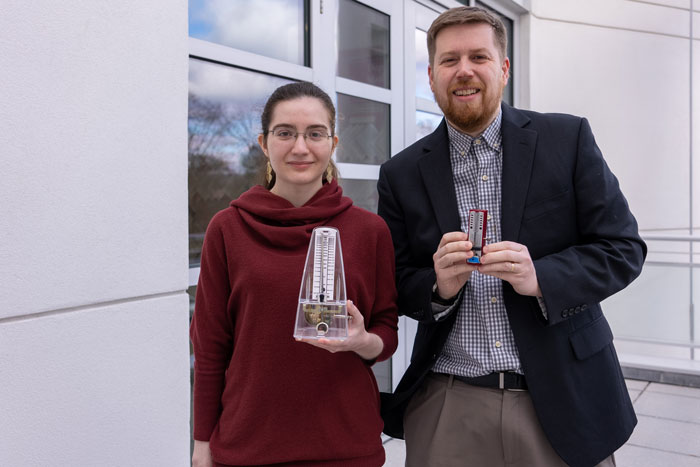Dickinson Students Publish Physics Paper With Renowned Mathematician

Professor of Physics Lars English and Emma Behta '22, with a couple of the metronomes they used in the experiment. Photo by Dan Loh.
Team explores the physics of synchronization using metronomes
by Tony Moore
What do you do when a renowned mathematician says he and a former student “had worked on capturing mathematically the discontinuity in the escapement mechanism of a metronome,” and he’d like to work with you on observing the phenomenon?
Well … assuming you know what that means ...
In this case, the renowned mathematician was Cornell University’s Steven Strogatz—host of Quanta magazine's “The Joy of x” podcast—and Professor of Physics Lars English was on the receiving end of the offer. And, knowing exactly what it meant, English and two of his students jumped at the opportunity to team up.
“It was definitely thrilling to collaborate with him, our department's last Priestley awardee,” says English, noting that Strogatz is a leader in the field of synchronization, having authored many high-impact papers in the literature and also writing the bestselling book Sync: The Emerging Science of Spontaneous Order.
The field of synchronization, where this project lived, touches many scientific areas of study, including physics, chemistry, engineering and biology.
“Qualitatively, synchronization refers to a phenomenon in which self-sustained oscillatory devices (e.g., metronomes) are coupled in such a way that even very weak interactions between the two can lead to an entirely different state of motion than if they remained separate,” says Emma Behta ’22 (physics), who worked with English on the project along with Hillel Finder ’22 (physics). (See variations of the experiments in videos Finder shot below.)
Explaining that coupling simply means that “one device can influence another’s motion through means that are not necessarily obvious to an observer,” she says, “the platform acts as a source of communication between the two pendulums, allowing each one to ‘feel’ the movements of the other.”
Finder sees his role in the process as a bridge of sorts. “I was the point of contact between the theories we were reading in the scientific literature and the reality of the project at hand,” he says, going on to note that his favorite part of the experience was exploring a configuration called oscillator death, in which the metronomes “fight” to control the motion of the platform, eventually leading to both ceasing to move altogether.
The experiment resulted in a paper, co-published by Strogatz, English and his students. But as with many things, the journey was its own reward.
“Between mathematics and notetaking, programing and tracking, it's hard to describe all the information and skills I learned with this experience,” says Finder. “Even beyond that, not only did I have an opportunity to work with some very good friends of mine, but I also got to play around with and discover something new and fascinating about a topic I had never considered before. It was really a win-win-win.”
TAKE THE NEXT STEPS
Published March 1, 2022